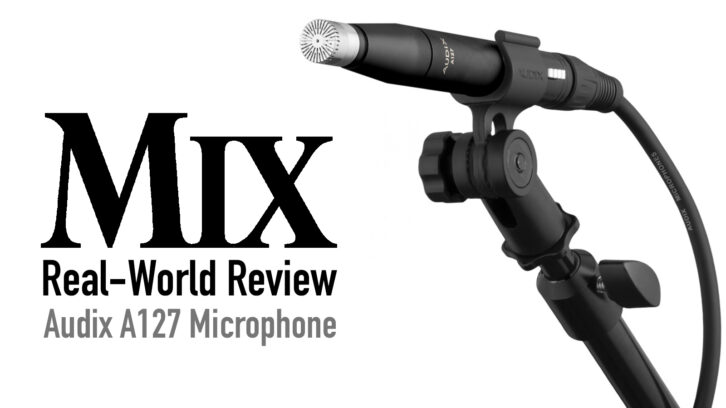
| MIX VERDICT: Audix A127 Omnidirectional Metal Film Condenser Microphone |
| THE TAKEAWAY: “Using the A127s was an absolute pleasure. The mic delivered whatever I put in front of it without adding an opinion.” |
| COMPANY: Audix • www.audixusa.com PRICE: $1,999 PROS: • Detailed, transparent reproduction. • Excellent build quality. CONS: • No HPF or pad • Output can overload some preamps • Expensive (but well worth it). |
Audix microphones need no introduction to Mix readers. Mics such as the D6, i5 and OM5/6 are in regular rotation worldwide as workhorses on stage and in the studio. The Audix A127, however, marks the company’s first step into the field of premium, high-performance condenser microphones. The A127 is a small-diaphragm, omnidirectional mic designed to deliver accurate, detailed reproduction without any coloration.
The heart of the A127 is a reference-grade, pre-polarized, half-inch capsule employing a 3-micron metal film diaphragm. This capsule is classified as Type 1, according to IEC 61094, a set of laboratory reference standards for measurement microphones specifying tight tolerances for sensitivity and distortion across a range of temperature, humidity and air pressure. In other words, the A127 was engineered for extremely consistent performance regardless of environmental conditions.
The capsule is coupled to a transformer-less, low-noise preamp, which—combined with the capsule—delivers a self-noise spec of 7 dB(A) and a frequency response from 10 Hz to 20 kHz. The entire package is built into an unassuming tapered black housing that’s machined from solid brass, then nickel-plated. The Audix logo, model number and serial number are laser-engraved for longevity.
The A127 ships in a softshell case with a windscreen, mic clip, and frequency response plot/sensitivity chart verifying performance for the serialized capsule. Applications include critical recording of acoustic instruments, ambient room recording and acoustic measurement. Audix provided Mix with a matched pair of A127s for this review.
MIKING THE KIT
The Audix A127 requires 48 VDC phantom power, ±4 VDC. A test using a portable 24 VDC phantom supply verified that the mic can be powered using lower voltages, but the recommended voltage should be used for optimum performance. Operation of the A127 is straightforward: There are no external controls such as a pad or HPF. The U-shaped mic clip is simple but effective, and locks via thumbscrew.
I first used the A127s for drum overheads on a live show, set as a spaced pair pointing straight down above the kit, approximately six feet high. The mics were plugged into the stock preamp inputs of an Avid Venue Profile, and even with the preamp gains set to minimum, A127 output levels were only a hair below clipping the preamps. I set a HPF around 350 Hz to roll off the low end, using the A127s to capture the cymbals and “top end” of the kit, with close mics on the toms, snare and kick. Listening to the cymbals through the P.A. system, the A127s sounded smooth and clear without nasty peaks, even from the “trash”-type cymbals that the drummer was using. Hi-hat sounded very natural, lacking the unwanted “spit” that you often hear from lesser condenser mics.
Next up were some studio sessions, the first in Studio A at Mercy College. Aided by Sam Stauff (Engineer and Associate Director, Music Studios), we recorded drums using the A127s, initially connecting them to a Neve 1073DPX. The A127s were placed as a spaced pair over the kit, pointing straight down, approximately seven feet high, five feet apart. Unfortunately for the 1073DPX, the A127s overloaded the preamps, even with the preamp pad turned on and the gain turned down all the way. We swapped the 1073DPX for an API 3124V preamp, which required the pads to be turned on, gain controls set to minimum, and output level controls set to 3 o’clock. The moral of the story: If your preamp doesn’t have enough gain to produce sufficient recording level with the A127s, don’t blame the microphones.
JBL Eon One MK2 Portable Live Sound — A Real-World Review
Keeping with the Audix theme, we added two close mics: a D6 on kick and an i5 on snare, both routed through Vintech X73i preamps. The results were excellent, with smooth crashes on hi-hat, excellent definition on snare and tom hits, and an overall sound leaning slightly toward the ribbon end of the spectrum. Toms and kick sounded nice but lacked some of the low end we expect these days when using close mics. Presence of the snare through the A127s was great, sounding much the same as if the snare were close-miked.
As we expected, the omnidirectional pattern captured a pretty good amount of room ambiance, though this can be tweaked by adjusting distance between mics and source. Ride patterns played on a crash cymbal were smooth and even, without any harshness. For this session, Sam and I split the outputs of the 3124V, routing one set straight into Pro Tools and the other through an API 2500 dialed in for some aggressive compression. The A127s took compression well, adding a nice “pffft’ on the attack of the snare drum, while emphasizing the room sound.
GUITAR, CHOIR, PIANO
We also tried the Audix A127s on acoustic guitar, first as a stereo spaced pair, then as a close and distant combination. The stereo pair was placed with one mic facing the bridge of the guitar and the other facing the area where the neck meets the body, both set about three feet away. The result was an excellent balance between the attack on the strings and resonance of the body: present, smooth and realistic, with rock-solid imaging.
We then moved the mics so that the mic facing the area where the neck meets the body was closer (now about 10 inches), and the other mic was about 12 feet away from the guitar. The close mic produced a beautiful, intimate sound, again with excellent reproduction of the instrument, and adding the room mic was like walking into the studio, i.e., very realistic. To add a bit of definition to fingerpicking, a touch of EQ did the trick: +4 dB @ 6 kHz, with medium bandwidth. Background noise from the mics was non-existent, a requirement when recording fingerpicked guitar or using a mic for ambient pickup.
Turning to a completely different application, I used the A127s to record a small choir, placing them directly in front of the group, spaced about eight feet apart. Voices were well-defined and articulate, though the spaced arrangement produced a hole in the middle. Closing the distance between the mics would have cured this issue but time did not permit, so I opted for bringing the pan controls to roughly 9 and 3 o’clock during playback. Due to the omni pattern of the Audix A127, the mics also captured some impressive bottom end from the church organ, and I definitely want to return there to record the organ on its own.
Mix Real-World Review: Neumann M 49 V Microphone
At the same facility, I recorded a Steinway grand piano using two distinctly different setups. The first was with the A127s outside of the piano case, mics spaced about five feet apart, peeking over the rim of the piano body and pointing straight in at the lid. This yielded too many reflections from the lid, causing a multitude of phase issues. I decided to move the mics inside the piano, this time placing them 10 to 12 inches above the strings, pointing toward the hammers, approximately three feet apart and set back from the hammers toward the end of the piano by around eight inches. The result was absolutely gorgeous. The A127s sounded clear and natural, with a perfect balance between the attack of the hammers and the resonance of the piano body, and the low end was full but not overbearing. These mics are not afraid of being used up-close; moving the mics in on the hammers decreased reflections from the lid, increased presence and made the piano sound more coherent—but not at the expense of sounding strident.
The A127s are not forgiving of placement, and the omni pattern means that your room needs to sound as good as the source. At my studio, I had to work harder on placement for drum overheads, and the A127s clearly revealed minor differences in location. For example, moving the mics from directly in front of my drum kit to a point approximately four or five feet away yielded a major difference in the amount of low end from the kick and toms. Lazy engineers will not get along well with the A127s.
Using the A127s was an absolute pleasure. The mic delivers whatever you put in front of it without adding an opinion. It’s transparent, quiet and captures as much detail as the rest of your recording chain will allow. The A127 can reveal subtle nuances overlooked by other microphones, it’s dead quiet and the response is ruler-flat from 10 Hz to 20 kHz. It’s a bit pricey, but make no mistake that the Audix A127 is a top-shelf microphone that stands up to any competition in the price range.







